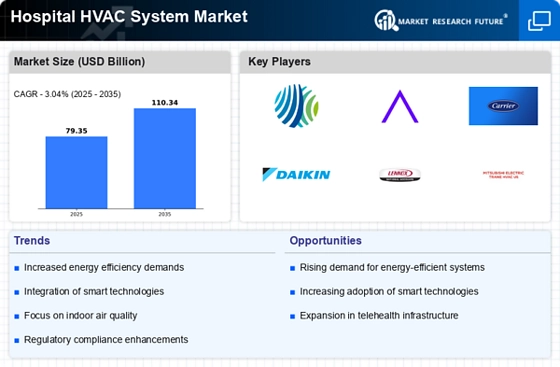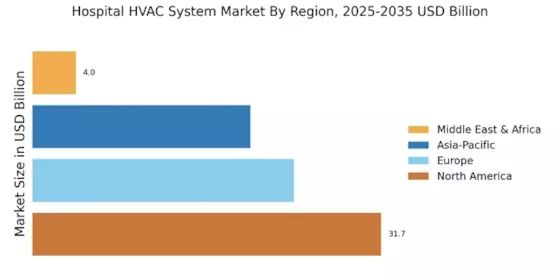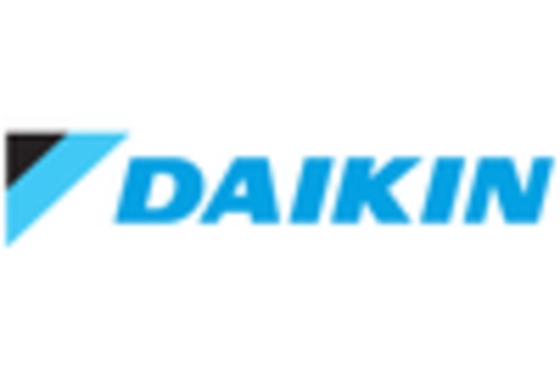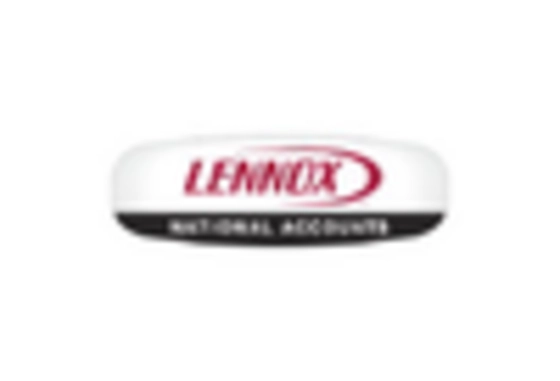Focus on Energy Efficiency
The Hospital HVAC System Market is increasingly driven by a focus on energy efficiency and sustainability. Hospitals are under pressure to reduce operational costs and minimize their environmental impact. Energy-efficient HVAC systems not only lower energy consumption but also contribute to a hospital's sustainability goals. Recent studies indicate that energy-efficient HVAC systems can reduce energy costs by up to 40%. This growing emphasis on sustainability is prompting healthcare facilities to invest in advanced HVAC technologies, thereby fostering growth in the Hospital HVAC System Market.
Rising Healthcare Expenditure
The Hospital HVAC System Market is significantly impacted by the rising healthcare expenditure observed in various regions. Increased investment in healthcare infrastructure, particularly in developing nations, is leading to the construction of new hospitals and the renovation of existing facilities. This trend is expected to continue, with healthcare spending projected to grow at a compound annual growth rate of 5.4% over the next five years. As hospitals expand and modernize, the demand for efficient and reliable HVAC systems is likely to rise, thereby driving the Hospital HVAC System Market forward.
Regulatory Compliance and Standards
The Hospital HVAC System Market is increasingly influenced by stringent regulatory compliance and standards aimed at ensuring patient safety and comfort. Governments and health organizations have established guidelines that mandate specific air quality and temperature control measures within healthcare facilities. For instance, the American Society of Heating, Refrigerating and Air-Conditioning Engineers (ASHRAE) provides standards that HVAC systems must meet to ensure optimal indoor air quality. Compliance with these regulations not only enhances patient care but also mitigates the risk of airborne infections. As a result, hospitals are compelled to invest in advanced HVAC systems that meet these standards, thereby driving growth in the Hospital HVAC System Market.
Increased Awareness of Indoor Air Quality
The Hospital HVAC System Market is experiencing growth due to heightened awareness of indoor air quality (IAQ) among healthcare providers and patients. Poor IAQ can lead to adverse health effects, particularly in vulnerable populations such as the elderly and those with pre-existing conditions. Hospitals are increasingly recognizing the importance of maintaining high IAQ standards to ensure patient safety and comfort. This awareness is driving the adoption of advanced HVAC systems equipped with superior filtration and ventilation capabilities. Consequently, the demand for such systems is expected to rise, further propelling the Hospital HVAC System Market.
Technological Advancements in HVAC Systems
The Hospital HVAC System Market is witnessing a surge in demand due to rapid technological advancements. Innovations such as variable refrigerant flow systems, advanced filtration technologies, and energy recovery ventilators are becoming increasingly prevalent. These technologies not only improve energy efficiency but also enhance air quality, which is crucial in hospital settings. According to recent data, the integration of smart HVAC systems can lead to energy savings of up to 30%. This trend towards modernization is compelling hospitals to upgrade their HVAC systems, thereby propelling the growth of the Hospital HVAC System Market.


















Leave a Comment